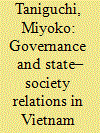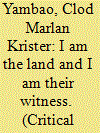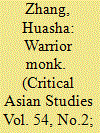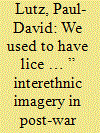|
|
|
Sort Order |
|
|
|
Items / Page
|
|
|
|
|
|
|
| Srl | Item |
| 1 |
ID:
185931


|
|
|
|
|
| Summary/Abstract |
The coronavirus disease (COVID-19) has given rise to dichotomous debates in international politics on whether authoritarian or democratic governance is more effective in responding to the pandemic. This study argues that the Vietnamese government, which is categorized as authoritarian, effectively managed the COVID-19 pandemic, at least until 2021, by utilizing vertical and horizontal political systems, networks, and social media platforms; increasing accountability and transparency through risk communication and providing scientifically credible information; and mobilizing organizations affiliated with the Communist Party of Vietnam (CPV) and its diverse stakeholders. In the process, these social attempts have provided more room for citizens to participate in combating this pandemic that has resulted in a change in state–society relations. However, this change might not continue in reforming daily life.
|
|
|
|
|
|
|
|
|
|
|
|
|
|
|
|
| 2 |
ID:
185934


|
|
|
|
|
| Summary/Abstract |
What happens to place-based, intergenerational knowledge in conditions of displacement? Here we attempt an answer to this question by reflecting on the experiences of the Indigenous peoples of Mindanao in the southern Philippines, collectively known as Lumads. For decades, Lumad communities have faced violence and displacement at the hands of the Philippine military, corporate armies, civilian militias, and rebel groups. Most accounts of Lumads portray them as passive victims who are “caught in between” warring factions of capitalists and leftists. This paper aims to augment a small but growing body of work that challenges such accounts and centers the historical agency of Lumads. In particular, we highlight some of the ways in which Lumads make life, place, and memory in the schools and community centers that they have established at three sites in Mindanao and Manila. In becoming Lumad places, these are sites in which Lumads of different ages, ethnicities, and social standings actively remake their relations with themselves, with their surroundings, and with others; they are sites of intergenerational communication and consternation; they are sites of pan-ethnic identity formation and solidarity; and they are sites of despair, repair, and potentially transformation.
|
|
|
|
|
|
|
|
|
|
|
|
|
|
|
|
| 3 |
ID:
185933


|
|
|
|
|
| Summary/Abstract |
This article revisits the Ninth Panchen Lama’s (Choekyi Nyima, 1883–1937) controversial exile in China and Inner Mongolia between 1924 and 1937. As the most renowned political dissenter of the then-nascent Tibetan state and the second most important religious leader for Mongolian and Tibetan Buddhists, the Ninth Panchen Lama played a significant role in the early-twentieth-century Chinese, Tibetan, and Mongolian political and spiritual worlds. Academic scrutiny of the Ninth Panchen Lama’s association with China has facilitated the scholarly understanding of the “subimperialist” policy that the Chinese Nationalist government devised to replicate the Qing Empire’s success in managing Mongol and Tibetan territories. Assisted by newly released sources and a shifting focus away from Chinese statesmen to the Tibetan monk, this article reassesses the power that the Ninth Panchen Lama wielded on the Sino–Mongol–Tibetan frontiers and his collaboration with the Chinese Nationalist government. This article argues that despite possessing many cosmetic features of the Qing-style relationship centering on the mutually agreed reinterpretation of an established status quo within a hierarchal framework, the alliance between the Ninth Panchen Lama and the Chinese Nationalist government was a venturesome entente based upon shared objectives that were audacious, contentious, and bore little resemblance to Qing precedent.
|
|
|
|
|
|
|
|
|
|
|
|
|
|
|
|
| 4 |
ID:
185930


|
|
|
|
|
| Summary/Abstract |
This paper discusses interethnic dynamics in a multi-ethnic Khmu and Akha village in the uplands of Phongsali Province, far-north Laos. It offers an intimate vignette on how local Khmu people’s patronizing disposition towards their Akha neighbors – and Sino-Tibetan highlanders more broadly – has been shaped by Laos’ recent history of war, revolution, and development. In particular, it shows how essentializing images of Akha as backward bumpkins in need of civilizing tutelage have provided local Khmu with a foil and platform for their pursuit of a culturally specific sense of modernity. In so doing, this paper refocuses the analysis of interethnic relations in Laos away from state-centered, lowland-upland, majority-minority frameworks, and towards localized, micro-regional and, most significantly, intra-upland dynamics. Concomitant to this refocus, this paper offers novel insights into the localized impact of Laos’ watershed civil war and its lingering aftermath. It also speaks to broader issues, including the applicability of the scholarly trope of “internal Orientalism” across scales, as well as the ethics and politics of researching inter-ethnic relations in a society still marked by the trauma of war.
|
|
|
|
|
|
|
|
|
|
|
|
|
|
|
|
| 5 |
ID:
185932


|
|
|
|
|
| Summary/Abstract |
As the first basic law of the People’s Republic of China (PRC), the launching of the Marriage Law on May 1, 1950, was the Chinese Communist Party’s (CCP) attempt to construct institutionalized and standardized criteria for social governance. However, tension between official reports and internal, confidential documents suggests that the implementation of the Marriage Law in Northeast China in the early 1950s confronted a series of difficulties. Due to the geographical and geopolitical distinctiveness of the region, the two priorities of the Northeast Bureau were the construction of heavy industry and support of the military during the Korean War (1950–1953). Within this context, frustrations with the Marriage Law were not simply a result of stubborn traditional opinions but reflected a conflict between different dimensions of modernity. Drafted before the founding of the PRC, the Marriage Law was representative of the party’s legislative project on women’s liberation, but local experiences eventually led to the Northeast Bureau’s pragmatic operation on women’s roles in the socialist regime. Under the varying forces constantly vying for control of women’s bodies, the liberation of Chinese women was not so much the purpose as a means of achieving the CCP’s project of nation-building.
|
|
|
|
|
|
|
|
|
|
|
|
|
|
|
|
| 6 |
ID:
185929


|
|
|
|
|
| Summary/Abstract |
This article’s premise is that war is ontological devastation, which opens up questions as to how to write about it. The paper contends that even critiques of war, whether critical-geopolitical analyses of global structures or ethnographies of the everyday, center war in ways that underscore erasures of non-war life, and therefore risk participating in that same ontological devastation. Engagement with extra-academic conversational worlds, both their social lives and their intellectual ones, is ethically necessary in writing war. To that end, this article examines poetic production from one front in the US-led “Global War on Terror”: Swat Valley, Pakistan. Poets in Swat have produced an analysis of war as ontological devastation, but also protest their reduction, in the minds of others and themselves, to the violence-stricken present. This intervention is not an intellectual critique alone. Focusing on a new genre of “resistance” poetry, this article shows how poets resist war by maintaining worlds partly beyond it. In this, the critical content and the social lives of poetry are inseparable.
|
|
|
|
|
|
|
|
|
|
|
|
|
|
|
|
| 7 |
ID:
185935


|
|
|
|
|
| Summary/Abstract |
In 1935, the Chinese central government, controlled at the time by the Nationalist Party (KMT), announced a diplomatic mission to escort the exiled Ninth Panchen Lama (Choekyi Nyima, 1883–1937) back to his monastic seat, the Tashilhunpo Monastery in Shigatse, Tibet. Zhuang Xueben (1909–1984), a twenty-six-year-old photographer, approached the head of the delegation, special emissary Chengyun, and volunteered to join. Chengyun, who had not yet recruited a photographer for the mission, welcomed Zhuang to the team.
|
|
|
|
|
|
|
|
|
|
|
|
|
|
|
|
|
|
|
|
|